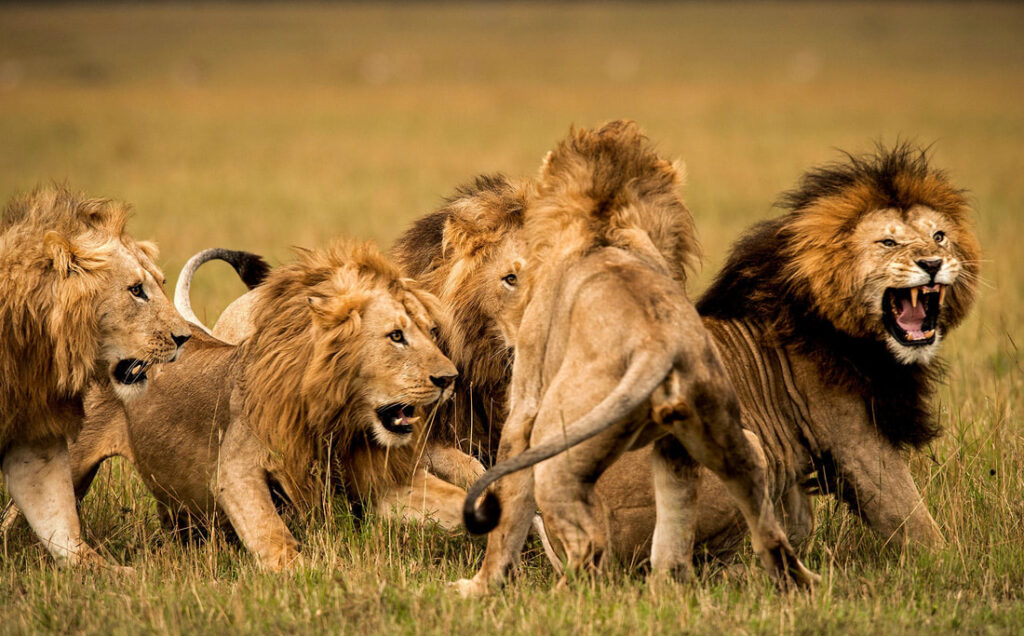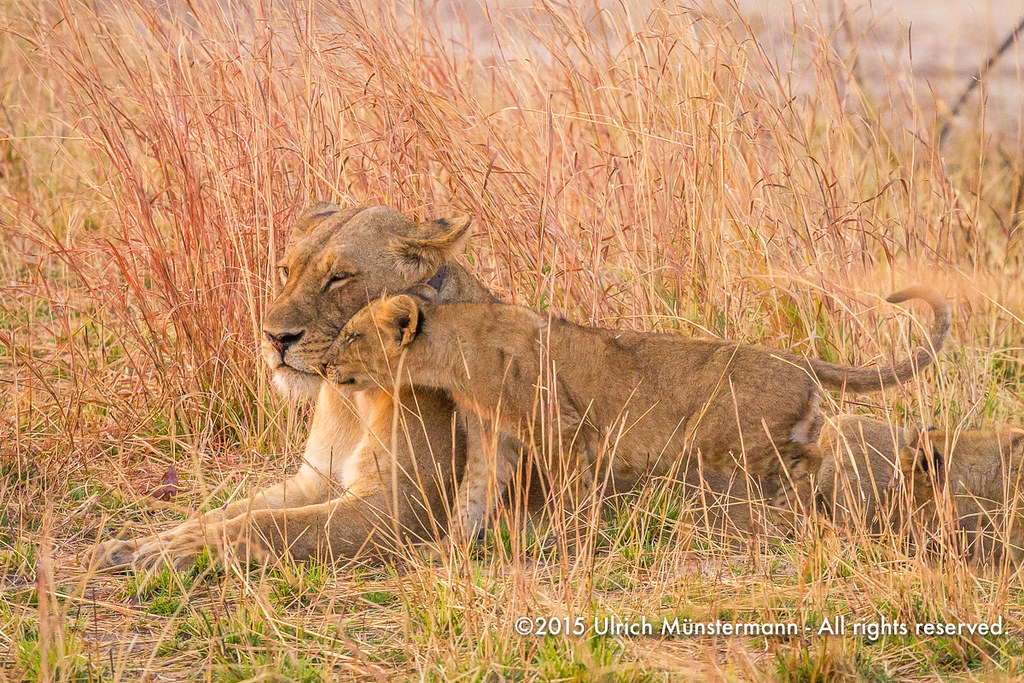- Our Story
About us
Bush blog
- Safaris
- Camps & Lodges
- Destinations
- Specials
- Our Foundation
- Get in Touch
Contact
International +27 21 701 0270 UK +0800 0418 187 US +1(888) 3441126 contact@africanbushcamps.comTalk to a Safari Expert
BOOK A CALL
Lion prides play a vital role in maintaining the balance of an ecosystem. As apex predators, they help to regulate the population of other species, which in turn affects the entire food chain. Lions also serve as indicators of the health of an ecosystem, as changes in their population size or behavior can indicate broader changes in the ecosystem.
One of the primary ways in which lion prides impact an ecosystem is through their hunting behavior. They target prey species such as antelopes, zebras, and buffaloes, which helps to control their population sizes and prevent overgrazing. This has a cascading effect on the vegetation, soil quality, and other species in the ecosystem.
Lion prides also play a social role in their ecosystem. They form intricate social structures, with females typically doing the majority of the hunting and males defending the territory from other predators and rival prides. These social dynamics can affect the behavior of other species in the ecosystem and help to maintain the balance of the food chain.
Below, we’ll list some of Southern Africa’s most infamous prides and where they are today.
One such pride is the Mapogo Coalition, which ruled the Sabi Sands region of South Africa from the mid-2000s to 2012. The Mapogo Coalition was made up of six male lions, who were known for their aggression and territorial behavior. They were feared by other prides in the area and were responsible for killing many rival lions.

Image: Trish the Activist
The Mapogo lions were a unique coalition as they had a tendency to kill any other lions they encountered. While it is not uncommon for lions to form coalitions, the size of the Mapogo coalition was exceptional with six members, granting them a significant advantage over other smaller coalitions. This allowed them to establish dominance over eight prides, altering the entire ecosystem of the Sabi Sands region.
Additionally, the Mapogo lions were known to hunt and kill larger prey such as adult giraffes, buffaloes, young rhinos, and hippos. This not only included other lions but also resulted in cannibalism. Their control over such a vast territory was unprecedented in the lion population and earned them a legendary reputation that will be remembered for years to come.
In 2012, Mr. T, who was considered the most ruthless of the Mapogo coalition, was defeated and killed by the Selatis, a rival coalition of four males known as the Southern Pride males. Following this, the other Mapogos disappeared under mysterious circumstances, leading to the disintegration of the legendary coalition.
The last remaining Mapogos, Makulu and Pretty Boy, were forced out of their territory after fighting with a coalition of two Kruger males. Although they were later seen together in 2012, Makulu was the only one spotted alone in 2013 in Mala Mala. At almost 15 years old, Makulu exceeded the average life expectancy of male lions which is typically eight to 10 year
The Mwamba-Kaingos pride is a famous pride of lions that roams the wilderness of the South Luangwa National Park in Zambia. The pride is known for its impressive size and hunting success, with the females working together to take down large prey such as buffalo.
The Mwamba-Kaingos pride is also notable for its unique characteristics and social dynamics. Unlike many other prides, the Mwamba-Kaingos pride has two sets of sisters that share the responsibilities of hunting, raising cubs, and defending the territory. This division of labor has allowed the pride to function more efficiently and successfully.

Photo by: Ulrich Munstermann
In addition, the Mwamba-Kaingos pride has been the subject of many wildlife documentaries and is a popular attraction for safari tourists. Visitors to the South Luangwa National Park can witness the pride’s hunting techniques and observe their interactions with other wildlife in the park.
Cecil was a male lion that lived in Hwange National Park in Zimbabwe and was the leader of a pride of lions known as the Cecil pride. The pride consisted of several females and their cubs, and they were known for their success in hunting elephants, which is a challenging and dangerous prey for lions.
In 2015, Cecil gained international attention when he was illegally killed by a trophy hunter. The incident sparked widespread outrage and brought attention to the issue of trophy hunting in Africa. The hunting of Cecil was especially controversial as he was a beloved and well-known lion in the Hwange National Park and had been the subject of many wildlife documentaries.
Despite the loss of their leader, the Cecil pride continued to thrive in the Hwange National Park. The females worked together to raise their cubs and hunt for food, and the pride remained an important part of the ecosystem. Efforts have been made to protect lions and other wildlife in the Hwange National Park from illegal hunting and other threats, and the Cecil pride serves as a reminder of the importance of conservation efforts.
The Selinda pride is a well-known pride of Okavango delta lions that inhabits the Selinda Reserve in northern Botswana. The pride is composed of several adult females, their cubs, and one or more male lions who protect the pride and its territory.
One of the notable characteristics of the Selinda pride is their success in hunting large prey such as buffalo and hippopotamus. They have also been known to take down other predators, including crocodiles and hyenas, which can be a threat to their cubs.
In addition, the Selinda pride has been the subject of research and conservation efforts aimed at protecting their habitat and maintaining their population. The Selinda Reserve is an important part of the ecosystem in northern Botswana, and the Selinda pride is one of the key species that helps to maintain the balance of the ecosystem.
Conservation of lion prides in Southern Africa is critical for maintaining the balance of the ecosystem and protecting these iconic animals from extinction. Here are some of the conservation efforts being made to protect lion prides in Southern Africa:
One of the most important steps in conserving lion prides is protecting their habitat. This involves creating and maintaining protected areas where lions can roam freely and safely. Many national parks and wildlife reserves in Southern Africa have been established for this purpose.
Lions are threatened by poaching for their body parts, which are used in traditional medicines and for other purposes. Anti-poaching measures such as increased surveillance, patrols, and penalties for poachers can help to deter this activity.
In areas where lions come into conflict with humans, conflict resolution strategies such as better livestock management practices, community education, and the establishment of buffer zones can help to reduce the incidence of human-lion conflict.
Wildlife tourism can provide a source of income for local communities and support conservation efforts. Responsible tourism practices such as minimizing disturbance to lions and their habitats can help to protect their populations.
Research and monitoring of lion populations can help to better understand their behavior, ecology, and population dynamics, which in turn can inform conservation strategies.
Overall, the conservation of lion prides in Southern Africa requires a multi-faceted approach that involves habitat protection, anti-poaching measures, conflict resolution, responsible tourism, and research and monitoring. By working together, conservation organizations, governments, and local communities can help to protect these majestic animals and preserve the balance of the ecosystem.
Lions are carnivores and primarily eat large prey such as antelopes, zebras, and buffalo. They will also eat smaller animals like rodents and birds if larger prey is scarce.
Lions use a combination of stealth, teamwork, and speed to hunt their prey. They typically ambush their prey, with females doing the majority of the hunting.
Lions can run up to speeds of around 50 miles per hour in short bursts.
Lions in the wild typically live around 10 to 14 years, while those in captivity may live up to 20 years.
Lionesses give birth to litters of 2 to 4 cubs after a gestation period of around 110 days.
Yes, lions are known for their distinctive roar, which can be heard up to 5 miles away.
Yes, lions are considered a vulnerable species due to habitat loss, poaching, and other threats. Conservation efforts are being made to protect their populations.
There is only one species of lion, but there are several subspecies that have distinct physical and behavioral characteristics.
Male lions typically weigh between 330 to 550 pounds, while females weigh between 265 to 395 pounds.
Yes, lions live in social groups called prides, which are typically composed of several females and their cubs, along with one or more male lions.